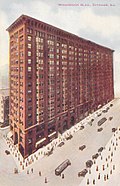| Revision as of 01:03, 26 September 2012 editMark Arsten (talk | contribs)131,188 editsm Remove a couple unneeded words← Previous edit | Latest revision as of 02:10, 1 October 2012 edit undoBongwarrior (talk | contribs)Administrators158,949 edits re-wikify | ||
| (3 intermediate revisions by 3 users not shown) | |||
| Line 1: | Line 1: | ||
| <div style="float: left; margin: 0.5em 0.9em 0.4em 0;">]</div> | <div style="float: left; margin: 0.5em 0.9em 0.4em 0;">]</div> | ||
| The ''']''' is a skyscraper in the south ] ] of ]. The north half of the building was built in 1891, and its decorative staircases |
The ''']''' is a skyscraper in the south ] ] of ]. The north half of the building was built in 1891, and its decorative staircases were the first use of aluminum in building construction. The south half (pictured), constructed in 1893, is similar in color and profile to the original, but the design is more traditionally ornate. When completed, it was the largest office building in the world. The building was remodeled in 1938 in one of the first major skyscraper renovations. It was sold in 1979 and restored to its original condition. The north half is an unornamented vertical mass of purple-brown brick, flaring gently out at the base and top. The south half is vertically divided by brickwork at the base and rises to a large copper ] at the roof. Projecting window ]s in both halves allow large exposures of glass, giving the building an open appearance despite its mass. It was added to the ] in 1970. Modern critics have called it a "triumph of unified design" and "one of the most exciting aesthetic experiences America's commercial architecture has produced". (]) | ||
| Recently featured: ] – '']'' – ] | Recently featured: ] – '']'' – ] | ||
| {{TFAfooter|Month= |
{{TFAfooter|Month=October|Year=2012}} | ||
Latest revision as of 02:10, 1 October 2012

The Monadnock Building is a skyscraper in the south Loop community area of Chicago, Illinois. The north half of the building was built in 1891, and its decorative staircases were the first use of aluminum in building construction. The south half (pictured), constructed in 1893, is similar in color and profile to the original, but the design is more traditionally ornate. When completed, it was the largest office building in the world. The building was remodeled in 1938 in one of the first major skyscraper renovations. It was sold in 1979 and restored to its original condition. The north half is an unornamented vertical mass of purple-brown brick, flaring gently out at the base and top. The south half is vertically divided by brickwork at the base and rises to a large copper cornice at the roof. Projecting window bays in both halves allow large exposures of glass, giving the building an open appearance despite its mass. It was added to the National Register of Historic Places in 1970. Modern critics have called it a "triumph of unified design" and "one of the most exciting aesthetic experiences America's commercial architecture has produced". (more...)
Recently featured: Nancy Drew – Armillaria luteobubalina – Rhyolite, Nevada